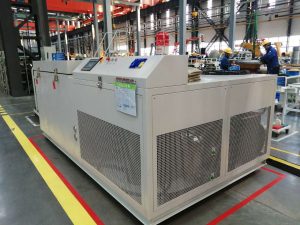What are the components that improve the performance of industrial chillers?
Industrial chillers are indispensable equipment in LNEYA production. With its normal operation, we will have better work efficiency and higher product quality. The refrigeration system of an industrial chiller is mainly composed of four core components: compressor, condenser, expansion valve and evaporator. On this basis, in order to improve the performance of industrial chillers, there are usually some auxiliary components.

(1) Compressors for industrial chillers:
It is the core of the entire chiller. Its quality is enough to affect the quality of a machine, and even the length of its lifespan. The compressor is the power source to ensure refrigeration. The compressor is used to increase the refrigeration pressure in the system, so that the refrigerant circulates in the refrigeration system to achieve the purpose of refrigeration. Common compressor types are open, semi-hermetic and fully-hermetic. Generally, the chiller with chilled water above 0°C adopts a fully hermetic compressor. If the chilled water is below 0°C, the low-temperature chiller uses a semi-hermetic compressor, while the open type is generally used in the refrigeration system with ammonia as the refrigerant.
(2) Condenser of industrial chiller:
It is the high temperature and high pressure Freon of the refrigeration system. After coming out of the compressor, it enters the condenser, releasing a lot of heat to the cooling medium, cooling and liquefying. There are three common types: water-cooled, air-cooled and evaporative. We mainly talk about water-cooled condensers. In a water-cooled condenser, the heat given off by the refrigerant is carried away by the cooling water. The cooling water can be flowed once or recycled. When using circulating water, cooling towers or cold pools are required. Water-cooled condensers have shell and tube, casing, immersion and other structural forms.
(3) Industrial chiller evaporator:
When the freon liquid in the refrigeration system enters the expansion valve and is sent to the evaporator, it belongs to the vaporization process. At this time, a large amount of heat needs to be absorbed, so that the temperature of the cooled medium is gradually lowered, so as to achieve the effect of cooling and cooling. According to the type of cooling medium, it is divided into two categories: cooling liquid (water) evaporator and cooling air evaporator.
(4) Industrial chiller expansion valve:
It is a throttling and pressure-reducing component that reduces the condensation pressure of the refrigerant to the evaporating pressure, so it is an essential component in the refrigeration system. It is called the four major components of the refrigeration system together with the compressor, the evaporator and the condenser.
Related recommendations
-
Troubleshoot fan failures in the cooling system of the engine powertrain
1541The fan is generally installed at the upper end of the cooling system of the engine powertrain, and some customers choose to install it on the side according to regulations. For screw chillers that use fans to dissipate heat, they are called air-c...
View details -
Description of driver chip power supply in chip test temperature control system
1337The chip test temperature control system is mainly for the cold heat source test equipment for various drive chips. Before the operation of the Wuxi Guanya chip test temperature control system, the user needs to know the power of the drive chip. I...
View details -
Application Note of Low Temperature Refrigerator for Cold Shrink Assembly of Automobile Engine Parts
1847Engine assembly is carried out in a low-temperature environment below minus 30°C in a low-temperature refrigerator. The mainstream automobile engine manufacturers have their own low-temperature assembly workshops. Engines assembled in a low-temper...
View details -
Core Maintenance Points of Ten High and Low Temperature Test Chamber Manufacturers
1525According to many years’ production experience of high and low temperature test chamber in Wuxi Guanya, it is found that many users are not very familiar with the maintenance of high and low temperature test chamber. As one of the top ten manufact...
View details
 LNEYA Industrial Chillers Manufacturer Supplier
LNEYA Industrial Chillers Manufacturer Supplier











